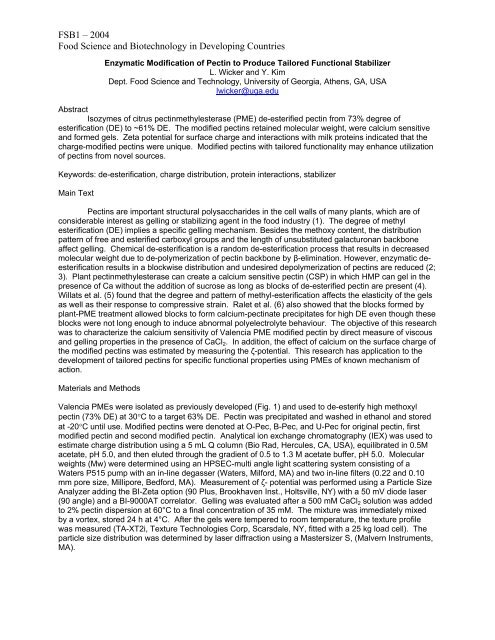PROTEASES FROM CELL CULTURE OF Bromelia hemisphaerica ...
PROTEASES FROM CELL CULTURE OF Bromelia hemisphaerica ...
PROTEASES FROM CELL CULTURE OF Bromelia hemisphaerica ...
Create successful ePaper yourself
Turn your PDF publications into a flip-book with our unique Google optimized e-Paper software.
FSB1 – 2004<br />
Food Science and Biotechnology in Developing Countries<br />
Enzymatic Modification of Pectin to Produce Tailored Functional Stabilizer<br />
L. Wicker and Y. Kim<br />
Dept. Food Science and Technology, University of Georgia, Athens, GA, USA<br />
lwicker@uga.edu<br />
Abstract<br />
Isozymes of citrus pectinmethylesterase (PME) de-esterified pectin from 73% degree of<br />
esterification (DE) to ~61% DE. The modified pectins retained molecular weight, were calcium sensitive<br />
and formed gels. Zeta potential for surface charge and interactions with milk proteins indicated that the<br />
charge-modified pectins were unique. Modified pectins with tailored functionality may enhance utilization<br />
of pectins from novel sources.<br />
Keywords: de-esterification, charge distribution, protein interactions, stabilizer<br />
Main Text<br />
Pectins are important structural polysaccharides in the cell walls of many plants, which are of<br />
considerable interest as gelling or stabilizing agent in the food industry (1). The degree of methyl<br />
esterification (DE) implies a specific gelling mechanism. Besides the methoxy content, the distribution<br />
pattern of free and esterified carboxyl groups and the length of unsubstituted galacturonan backbone<br />
affect gelling. Chemical de-esterification is a random de-esterification process that results in decreased<br />
molecular weight due to de-polymerization of pectin backbone by β-elimination. However, enzymatic deesterification<br />
results in a blockwise distribution and undesired depolymerization of pectins are reduced (2;<br />
3). Plant pectinmethylesterase can create a calcium sensitive pectin (CSP) in which HMP can gel in the<br />
presence of Ca without the addition of sucrose as long as blocks of de-esterified pectin are present (4).<br />
Willats et al. (5) found that the degree and pattern of methyl-esterification affects the elasticity of the gels<br />
as well as their response to compressive strain. Ralet et al. (6) also showed that the blocks formed by<br />
plant-PME treatment allowed blocks to form calcium-pectinate precipitates for high DE even though these<br />
blocks were not long enough to induce abnormal polyelectrolyte behaviour. The objective of this research<br />
was to characterize the calcium sensitivity of Valencia PME modified pectin by direct measure of viscous<br />
and gelling properties in the presence of CaCl2. In addition, the effect of calcium on the surface charge of<br />
the modified pectins was estimated by measuring the ζ-potential. This research has application to the<br />
development of tailored pectins for specific functional properties using PMEs of known mechanism of<br />
action.<br />
Materials and Methods<br />
Valencia PMEs were isolated as previously developed (Fig. 1) and used to de-esterify high methoxyl<br />
pectin (73% DE) at 30°C to a target 63% DE. Pectin was precipitated and washed in ethanol and stored<br />
at -20°C until use. Modified pectins were denoted at O-Pec, B-Pec, and U-Pec for original pectin, first<br />
modified pectin and second modified pectin. Analytical ion exchange chromatography (IEX) was used to<br />
estimate charge distribution using a 5 mL Q column (Bio Rad, Hercules, CA, USA), equilibrated in 0.5M<br />
acetate, pH 5.0, and then eluted through the gradient of 0.5 to 1.3 M acetate buffer, pH 5.0. Molecular<br />
weights (Mw) were determined using an HPSEC-multi angle light scattering system consisting of a<br />
Waters P515 pump with an in-line degasser (Waters, Milford, MA) and two in-line filters (0.22 and 0.10<br />
mm pore size, Millipore, Bedford, MA). Measurement of ζ- potential was performed using a Particle Size<br />
Analyzer adding the BI-Zeta option (90 Plus, Brookhaven Inst., Holtsville, NY) with a 50 mV diode laser<br />
(90 angle) and a BI-9000AT correlator. Gelling was evaluated after a 500 mM CaCl2 solution was added<br />
to 2% pectin dispersion at 60°C to a final concentration of 35 mM. The mixture was immediately mixed<br />
by a vortex, stored 24 h at 4°C. After the gels were tempered to room temperature, the texture profile<br />
was measured (TA-XT2i, Texture Technologies Corp, Scarsdale, NY, fitted with a 25 kg load cell). The<br />
particle size distribution was determined by laser diffraction using a Mastersizer S, (Malvern Instruments,<br />
MA).



